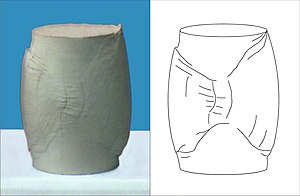剪切帶 (材料工程)
剪切帶(shear band)是材料中一個狹窄的強剪切應變區,通常在延性材料嚴重變形時出現,具有可塑性。剪切帶會比材料的其他部位先失去韌性,剪切帶中發生的極端變形可能導致材料嚴重的損壞和斷裂,因此研究剪切帶如何形成是一個對材料應用非常重要的課題,20世紀中葉以來變形局部化(localization of deformation)一直被密集研究。

此條目翻譯自其他語言維基百科,需要相關領域的編者協助校對翻譯。 |
有剪切帶的材料
編輯剪切帶或更普遍的「局部變形」通常會在廣義的延展性材料(合金、金屬、顆粒材料、塑料、聚合物和土壤)甚至在准脆性材料(混凝土、冰、岩石和一些陶瓷)中發生,脆性材料(例如室溫下的玻璃)中則無法觀察到剪切帶。
數學建模
編輯剪切帶是影響材料不穩定性的因素,使固體樣品突然喪失變形均勻性(homogeneity of deformation),即使其受力的傳力路徑(loading path)與持續均勻變形兼容。從這個意義上說,它可以被解釋為一種「替代」微不足道的變形機制,因此是分叉或失去「完美」均衡路徑的唯一性。這種分叉的顯着特徵是它甚至可能發生在無限體中(或在與剛性約束平滑接觸的極端約束下)。
考慮一個由非線性材料組成的無限體,它以一種應力和應變可能保持均勻的方式准靜態變形。為簡單起見,假設這種非線性材料的增量反應為線性,因此它可以表示為應力增量之間的關係 和應變增量 ,通過一個四階本構張量 表示為
其中四階本構張量 取決於當前狀態,即當前應力、當前應變以及可能的其他本構(該物質特性)參數(例如金屬的硬化變量或顆粒材料的密度)。 尋找出現不連續面的條件(單位法向量 ) 的增量應力和應變。這些條件與發生變形局部化的條件相同。特別是,增量平衡要求增量牽引力(不是應力!)保持連續
(其中 + 和 - 表示表面的兩側)和幾何兼容性對增量應變的形式施加了應變兼容性限制:
符號 表示張量積和 是定義變形不連續模式的向量(正交於 對於不可壓縮材料)。將增量本構定律(1)和應變相容性(3)代入增量牽引(2)的連續性,得出應變定位的必要條件:
由於二階張量 定義每個向量 為
這是所謂的「聲學張量」(acoustic tensor),定義了加速度波的傳播條件,我們可以得出結論,應變局域化條件與加速度波的奇異性(零速傳播)條件一致。該條件代表了控制速率平衡的微分方程的所謂「橢圓度(扁率)損失」。
剪切帶和晶體結構
編輯大多數多晶體金屬或合金會因為差排、孿晶或剪切帶引起剪切變形,導致它們的塑性在晶粒尺度上各方向不同,因此造成多數晶粒具有類似的結晶方位,此現象被稱為結晶織構,大部分面心立方金屬和合金的冷軋織構介於黃銅型織構和銅型織構兩種類型之間。堆垛層錯(Stacking-fault energy,原子堆疊次序發生差錯)是此機制的影響因素之一,高堆垛層錯的面心立方金屬中,主要是差排的滑移促使織構形成;低堆垛層錯、有機械孿晶(晶格受力滑移導致的雙晶)和剪切帶的金屬與合金中,織構則與做為主要載體的差排滑移一起產/發生。
在任何一種情況下,非晶體剪切帶(non-crystallographic shear banding)對於演化出的特定類型的變形紋理都起着至關重要的作用。 [1] [2]
微擾方法與檢測
編輯可以通過微擾方法研究剪切帶的形成(包括在樣本處於變形狀態且未受干擾的情況下疊加擾動場的情況)[3][4],可以通過疊加集中力、製造裂紋或藉由剛性線夾雜物(Rigid line inclusion)來擾動檢測樣本。本方法適合應用於無限、不可壓縮、非線性彈性、在平面應變條件下均勻變形的材料。
已經發現,當樣本的未擾動狀態接近定域條件(4)時,擾動場會以定域場的形式自排列,在引入的擾動附近呈現極值並沿着剪切帶聚焦方向。在裂紋或剛性線狀夾雜物的情況下,這種剪切帶會從線狀夾雜物的尖端顯現。 [5]
在微擾方法中,引入了有限長度剪切帶的增量模型[6]以規定沿其表面的以下條件:
- 零增量標稱剪切牽引力;
- 增量標稱法向牽引力的連續性;
- 法向增量位移的連續性。
使用該模型,剪切帶的以下主要特徵已得到證明:
- 類似於斷裂力學,應力/變形場中的平方根奇點在剪切帶尖端發展;
- 在剪切帶存在的情況下,應變場是局部的並且強烈地集中在平行於剪切帶的方向上;
- 由於與剪切帶增長相關的能量釋放率在局部條件(4)附近爆炸到無窮大,因此剪切帶代表優先失效模式。
最新研究
編輯根據相關實驗[7][8][9][10]、理論[11][12][13][14][15][16][17][18][19],以及材料的力學數學模型(即本構模型 constitutive models),目前已經可以對剪切帶進行很好的定性預測,然而定量預測的技術通常很差[20]。
數據模擬大有進步[21][22][23][24],使剪切帶的形成和傳播的數據在相對複雜的情況下還是可以用有限元模型(finite element models)追蹤,儘管需要巨大的計算工作。
更令人感興趣的是剪切帶的模擬,從中可以研究剪切帶在單晶或多晶材料中的晶體取向依賴性(crystallographic orientation dependence)情況如何。目前的研究結果表明,某些方向比其他方向更容易發生剪切定位[25]。
參見
編輯參考資料
編輯- ^ Jia, N.; Roters, F.; Eisenlohr, P.; Raabe, D.; Zhao, X. Simulation of shear banding in heterophase co-deformation: Example of plane strain compressed Cu–Ag and Cu–Nb metal matrix composites. Acta Materialia (Elsevier BV). 2013, 61 (12): 4591–4606. ISSN 1359-6454. doi:10.1016/j.actamat.2013.04.029.
- ^ Jia, N.; Eisenlohr, P.; Roters, F.; Raabe, D.; Zhao, X. Orientation dependence of shear banding in face-centered-cubic single crystals. Acta Materialia (Elsevier BV). 2012, 60 (8): 3415–3434. ISSN 1359-6454. doi:10.1016/j.actamat.2012.03.005.
- ^ Bigoni, D. and Capuani, D. (2002) Green's function for incremental nonlinear elasticity: shear bands and boundary integral formulation. Journ. Mech. Phys. Sol. 50, 471-500.. [2021-07-31]. (原始內容存檔於2020-08-18).
- ^ Bigoni, D. and Capuani, D. (2005) Time-harmonic Green's function and boundary integral formulation for incremental nonlinear elasticity: dynamics of wave patterns and shear bands. Journ. Mech. Phys. Sol. 53, 1163-1187.. [2021-07-31]. (原始內容存檔於2020-08-18).
- ^ Dal Corso F. and Bigoni D. (2009) The interactions between shear bands and rigid lamellar inclusions in a ductile metal matrix. Proc. R. Soc. Lond. A, 465, 143-163.. [2021-07-31]. (原始內容存檔於2020-08-18).
- ^ Bigoni, D. and Dal Corso, F. (2008) The unrestrainable growth of a shear band in a prestressed material. Proc. R. Soc. Lond. A, 464, 2365-2390.. [2021-07-31]. (原始內容存檔於2020-08-18).
- ^ Knodel, PC; Drescher, A; Vardoulakis, I; Han, C. A Biaxial Apparatus for Testing Soils. Geotechnical Testing Journal (ASTM International). 1990, 13 (3): 226-234. ISSN 0149-6115. doi:10.1520/gtj10161j.
- ^ Desrues, J.; Lanier, J.; Stutz, P. Localization of the deformation in tests on sand sample. Engineering Fracture Mechanics (Elsevier BV). 1985, 21 (4): 909–921. ISSN 0013-7944. doi:10.1016/0013-7944(85)90097-9.
- ^ Vardoulakis, I. Rigid granular plasticity model and bifurcation in the triaxial test. Acta Mechanica (Springer Science and Business Media LLC). 1983, 49 (1-2): 57–79. ISSN 0001-5970. doi:10.1007/bf01181755.
- ^ Poirier, C.; Ammi, M.; Bideau, D.; Troadec, J. P. Experimental study of the geometrical effects in the localization of deformation. Physical Review Letters (American Physical Society (APS)). 1992-01-13, 68 (2): 216–219. ISSN 0031-9007. doi:10.1103/physrevlett.68.216.
- ^ Bigoni, D. Nonlinear Solid Mechanics: Bifurcation Theory and Material Instability. Cambridge University Press, 2012. ISBN 9781107025417.
- ^ Rudnicki, J.W.; Rice, J.R. Conditions for the localization of deformation in pressure-sensitive dilatant materials (PDF). Journal of the Mechanics and Physics of Solids (Elsevier BV). 1975, 23 (6): 371–394 [2021-07-31]. ISSN 0022-5096. doi:10.1016/0022-5096(75)90001-0. (原始內容 (PDF)存檔於2021-07-31).
- ^ Thomas, T.Y. (1961) Plastic flows and fracture of solids. Academic Press, New York.
- ^ Rice, J. R. (1977) The localization of plastic deformation. In Koiter, W.T., ed., Theoretical and Applied Mechanics. Amsterdam, North-Holland. 207-220.. [2021-07-31]. (原始內容存檔於2021-07-24).
- ^ Bigoni, Davide; Hueckel, Tomasz. Uniqueness and localization—I. Associative and non-associative elastoplasticity. International Journal of Solids and Structures (Elsevier BV). 1991, 28 (2): 197–213. ISSN 0020-7683. doi:10.1016/0020-7683(91)90205-t.
- ^ Biot, M.A. (1965) Mechanics of incremental deformations. New York, Wiley.
- ^ Hill, R. Acceleration waves in solids. Journal of the Mechanics and Physics of Solids (Elsevier BV). 1962, 10 (1): 1–16. ISSN 0022-5096. doi:10.1016/0022-5096(62)90024-8.
- ^ Mandel, J. (1962) Ondes plastiques dans un milieu indéfini à trois dimensions. J. de Mécanique 1, 3-30.
- ^ Nadai, A. (1950) Theory of flow and fracture of solids. McGraw-Hill, New York.
- ^ Gajo, A., Bigoni, D. and Muir Wood, D. (2004) Multiple shear band development and related instabilities in granular materials. J. Mech. Phys. Solids 52, 2683-2724.. [2021-07-31]. (原始內容存檔於2020-08-18).
- ^ Leroy, Y.; Ortiz, M. Finite element analysis of transient strain localization phenomena in frictional solids. International Journal for Numerical and Analytical Methods in Geomechanics (Wiley). 1990, 14 (2): 93–124. ISSN 0363-9061. doi:10.1002/nag.1610140203.
- ^ Petryk, H.; Thermann, K. Post-critical plastic deformation in incrementally nonlinear materials. Journal of the Mechanics and Physics of Solids (Elsevier BV). 2002, 50 (5): 925–954. ISSN 0022-5096. doi:10.1016/s0022-5096(01)00131-4.
- ^ Nacar, A.; Needleman, A.; Ortiz, M. A finite element method for analyzing localization in rate dependent solids at finite strains. Computer Methods in Applied Mechanics and Engineering (Elsevier BV). 1989, 73 (3): 235–258. ISSN 0045-7825. doi:10.1016/0045-7825(89)90067-4.
- ^ Loret, Benjamin; Prevost, Jean H. Dynamic strain localization in elasto-(visco-)plastic solids, Part 1. General formulation and one-dimensional examples. Computer Methods in Applied Mechanics and Engineering (Elsevier BV). 1990, 83 (3): 247–273. ISSN 0045-7825. doi:10.1016/0045-7825(90)90073-u.
- ^ Jia, N.; Roters, F.; Eisenlohr, P.; Kords, C.; Raabe, D. Non-crystallographic shear banding in crystal plasticity FEM simulations: Example of texture evolution in α-brass. Acta Materialia (Elsevier BV). 2012, 60 (3): 1099–1115. ISSN 1359-6454. doi:10.1016/j.actamat.2011.10.047.